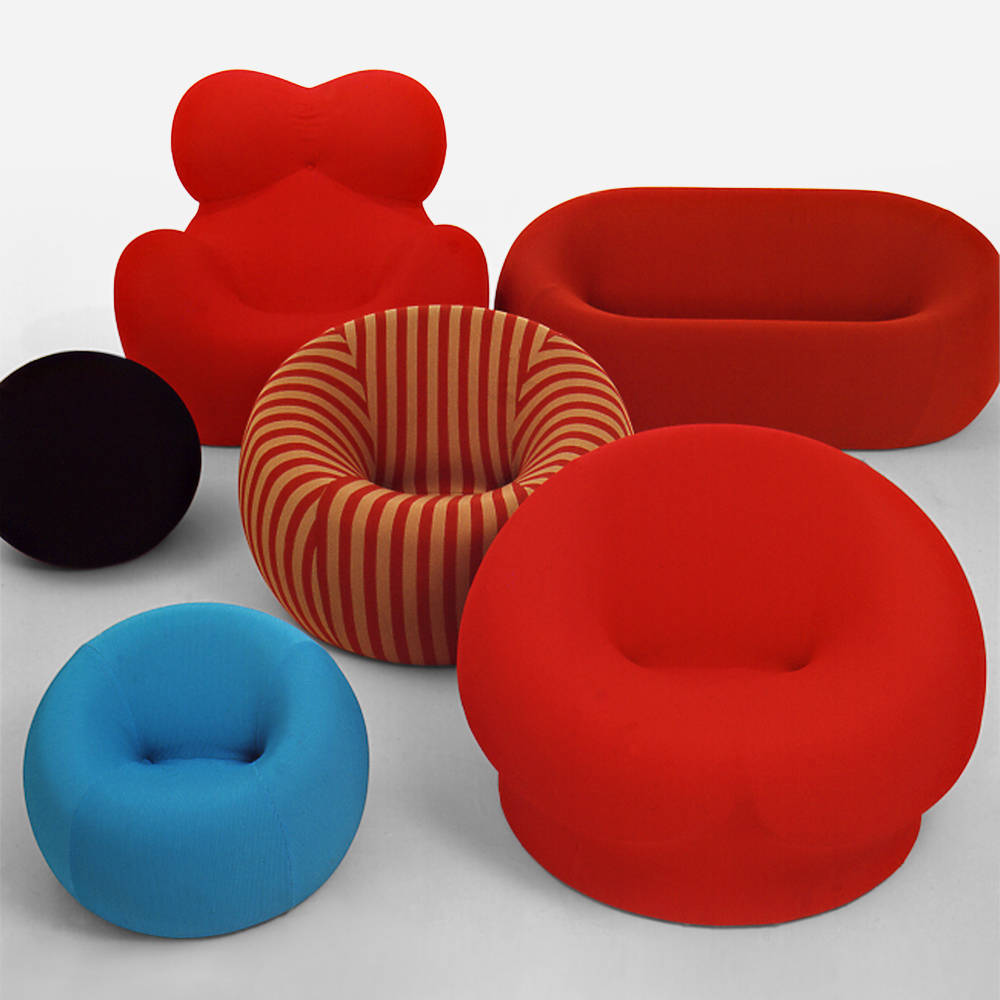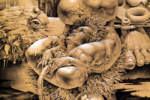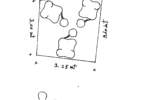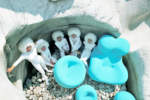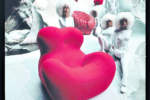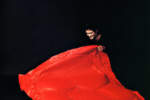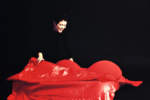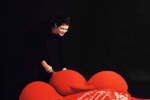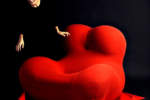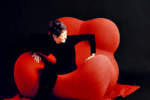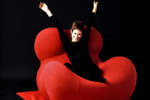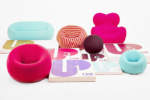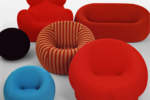architect: B&B
year: 1969
Abstraction proceeds by degrees. Every representation both pares and substitutes, proposing a way of seeing as well as a vision of its object. Painting and drawing – whether Lascaux or Leonardo – confronts the primary abstraction of worldly depiction: the removal of the third dimension from the medium of representation, giving rise to the optical magic of perspective, begged by the question of distance. This is not a matter of idealism or essence but does raise the question of content. What meets the idea in a work of art always represents something.
Modernism bridled against this fact, understanding representation as constraint. To defeat this, modern art produced the idea of abstraction and conscientiously diversified its methodologies. Cubism broke down the object via conceits of simultaneity and geometric reduction. Surrealism abstracted by the free interchange of object and context. The Russians assaulted optic prejudice via the representation of geometry, itself an abstraction. This last style of representation had a particularly profound effect on architecture and design, liberating objects to express primarily the conditions of their own construction.
This also gave rise to a rhetoric of immanence, to the idea that construction and expression were completely isomorphic. Obscured was the object’s powerful representation of the desire for the palpable. The artistic and architectural worlds were responding, in part, to the press of technical events that fell increasingly outside their purview.
Art was challenged by the proliferating, deadpan, expression of engineering and science, a system that grew increasingly hermetic and bold in meeting its own needs. The dazzling technological artifacts of the past two centuries conjoined to produce a vast system of visuality that was largely indifferent to received formal criteria. This was a tremendous challenge to the enterprise
of art, which was forced out of its role in the vanguard of cultural expression.
What was easel painting in the era of the Great Eastern or the Brooklyn Bridge? What was the relevance of history in the face of such enormous ruptures as the world wars?
In the face of these social and technical convulsions, art responded both enthusiastically and critically. The pornography of Futurism, the free association of collage, the asymptotic reductivism of “pure” abstraction and of minimalism, the evanescence of performance art, the private authenticity of action painting, all sought to make art in light of new technologies of both making and seeing. An oscillation between embrace and horror defined the condition of modern art and defines it still. Most recently, the idea that art is the representation of something amorphously defined
as “theory” at once allies the artistic with an idea of a rigorous, analytical, scientific “progress” and allows it to continue to flirt with its old styles of depiction, if with an increasingly rarefied object. The highly theorized art of today is decidedly post-romantic. If sublimity is alterity – the experience of otherness – depiction becomes sentimental, a sublimated sublime. This is, of course,
a highly idealist picture and we receive it as relentlessly identified with the bourgeoisie and its cozy notions of the security of what is seen.
In this reading, the “framed view” must always answer for its exclusions, own up to the narrowness of its self-interest. Indeed, the modernist default is to relegate all representation to the territory of kitsch, pathos lapsed into bathos.
Surrealism, the working method of modern life, recuperates representation via irony. This extends beyond the droll atmosphere of its charged juxtapositions to its dramatic breakdown of distinctions of high and low, of what is properly artistic and what is mere consumption. Duschamp’s “discovery” of the ready-made insisted that the act of seeing differently was a sufficient definition of artistic practice. This mode of observation had the power to “turn” objects from one thing to another. Whether this was a urinal brazenly hung on a gallery wall or a deft bike-part bull, this mode of art-making used the mass-produced consumer object as its medium. However, its critical relation to this means depended on devaluing its useful status to convert it to mere contemplation, bringing it in line with traditional styles of artistic valorization. The period of early modernity is also the period in which the discipline of industrial design originates.
Like modern architecture, industrial design depends on the prior representation of the object to be produced ad seriatim by machines.
This relocation – with its separation of designing and making – was also taken up in the discourse of the appropriate form of the industrial object and of the manner in which it was
to be judged. While the mythic rhetoric of functionalism provided and continues to provide the main means of judging such production, it was clear from the outset that this was not nearly enough.
In this sense, both William Morris and the Bauhaus represent similar styles of resistance to the anonymity of the mass-object - dosing it up with craft or style that far exceeds the simple requirements of use. All of which is a somewhat long-winded way of suggesting that abstract art seethed with both represented meanings and with their denial.
In mainstream architecture, this contradiction offered an especially intractable dead-end, such that by the nineteen sixties the gigantic vacancy of corporate minimalism that had come to largely dominate the sanctioned face of architecture and was ready to take a fall. The assault came from many competitors, including historicists, sentimentalists, and ironists, as well as from the free-for-all visual convulsions of the counter-culture with its tooth for depiction – however mind altered – and its political critique of the oppressive forms of late capitalism.
In this re-creation of the art of design, there was (and is) no greater figure than Gaetano Pesce who – as no other practitioner of recent times - recaptures representation for both politics and pleasure. To a degree, this is accomplished by a strategy of “turning” but not precisely the kind favored by the likes of Ant-Farm or Archigram, with their affectionate capture of mass-consumables like cars, comics, cozy suburbs, advertising, etc. Pesce has instinctively understood something a level deeper, that the creation of images – in particular images of the human body – is a fundamental property of the way we behave as a species and also a means of defending the body against the threats of “post-human” culture. His work – at all scales – is suffused with body images, artfully abstracted to retain an energetic balance between media and message.
But if this friendly inclusion of the human image were the end of it, Pesce’s place would be misunderstood. His genius has been to unite his frank and idiosyncratic representational style with a vivid politics of craft and meaning and with an enthusiastic, adept, and brilliant use of new technology. While the majority of his cohort continues to work out the model of the rigid, metal, machine (however cowled in voluptuous shape or soft skins), Pesce has understood that the organic is a concept that far exceeds loosey-goosey forms, that organisms are both hard and soft, that matter appears in different phases and guises, and that the human body is the eternal subject of architecture and domestic design.
Serie Up (and particularly the Up 5/6 chair) is a vivid example of Pesce’s precise embodiment of meaning and technique in useful and artistic objects. In the late sixties, when foam was a material
of considerable fascination for designers, Pesce had a transcendently useful insight: foam is largely air. With B&B Italia, he designed a system for removing the air from foam furniture and vacuum-packing it such that the volume to be shipped was a mere fraction of the volume to be used. Thanks to foam’s own “shape memory”, chairs squashed to pancake proportion rapidly – on being liberated from their packaging – resumed their shape and rigidity. This is surely one of the most astonishing innovations in the history of furniture design. In many ways, this “inflatable” technology inverts the preoccupation with inflatables that was so prevalent at the time. While Pesce’s peers around the world produced endless variations on the balloon – inflatable objects as mere air supported membranes – Pesce was the first to produce an inflatable mass. This nearly alchemical transaction is breathtaking both in its innovation and in the fundamental simplicity
of the observation that inspired it. The re-animation of the chair by exposure to the air is miraculous.
Up 5/6 takes this innovation another step, layering the image of the body to support the body-to-be-seated. But not just any body, a woman’s. To say that the female body was contested territory in this era - time of The Stepford Wives with its docile robot-women, of pneumatic , hyper- objectified, Playboy bunnies, of inflatable sex-toys, and of the raging, liberating reaction of the women’s movement – is to gravely understate the situation. Pesce responded by carrying his design a little further, providing an “ottoman” (another colonization) for the chair/woman in the form of a ball and chain. The meaning is clear: the woman objectified is a prisoner. But there’s ambiguity as well and this, too, is part of Pesce’s genius. The chair is beautiful and, consequently, so too the represented woman. Her oppression seems so much more drear because the victim is so robust and generous. In Pesce’s mind, the image of the woman’s body could – at that historical moment – only be recuperated for artistic representation with appropriate critique. This contradiction – that an appliance designed to serve the body could only represent it with visible qualifications – captures something central to the struggles of that time and the present. In the work of Gaetano Pesce, a chair acquires astonishing eloquence.


